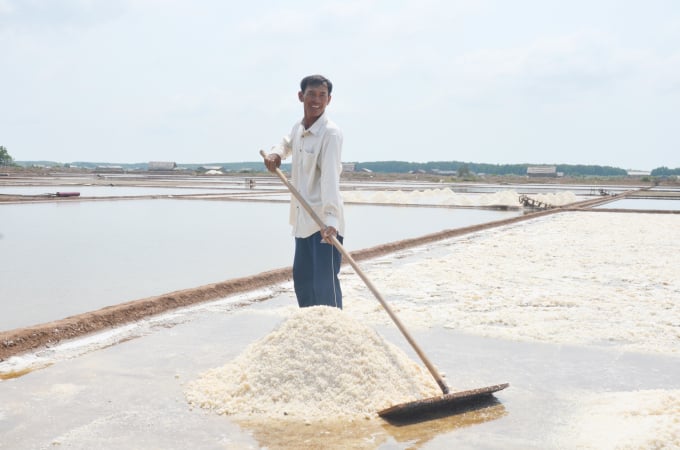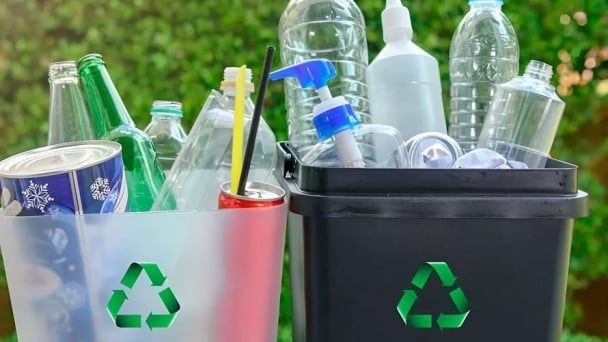May 19, 2025 | 18:27 GMT +7
May 19, 2025 | 18:27 GMT +7
Hotline: 0913.378.918
May 19, 2025 | 18:27 GMT +7
Hotline: 0913.378.918
On January 21, the Ministry of Agriculture and Rural Development (MARD) held a workshop to promote investment and connect salt production and consumption between cooperatives and salt enterprises.
According to Mr. Le Duc Thinh, Director of the Department of Cooperatives and Rural Development (DCRD - MARD), Vietnam's salt production area tends to decrease in recent years:
In 2018 the salt area was more than 13,000 ha, more than 12,400 ha, and more than 11,900 ha in 2020. By 2021 Vietnam's salt production area was approximately 11,300 ha (with an output of more than 914,900 tons).
The fundamental cause of this decrease is the low income of this profession. Many households have gradually altered ineffective production land for aquaculture or changed to other occupations.

Deputy Minister of Agriculture and Rural Development Tran Thanh Nam speaking at the workshop. Photo: Trung Quan.
In terms of production, the number of small-scale processing establishments accounted for 80.3%. The commonly used production technology, machinery and equipment are shaft mill, hammer mill, and intermittent centrifuge. This causes instability among the processed salt and heavy dependence on the quality of the material. Salt recovery in processing is low, less than 80%.
Regarding imports and exports, the amount of salt imported under the assigned tariff quota remains low, not enough to meet the demand for chemical production. Domestic salt material source has yet met the quality standards.
Vietnam's clean, rich in trace elements and healthy sea salt products have been exported to a number of countries such as the USA, Japan, and South Korea. But the export volume is still small, only 20,000 - 40,000 tons/year on average.

Ms. Marion Chaminade, French Agricultural Counselor in Vietnam sharing her experiences in developing France’s salt industry. Photo: Trung Quan.
Mr. Le Duc Thinh said that the salt industry will focus on improving productivity, quality and product variance in the near future to satisfy domestic demand, gradually replacing imported salt by 400,000 - 600,000 tons/year, aiming for exportation.
The total salt production area will exceed 14,200 ha by 2030. Output will reach 2 million tons/year, meeting 100% of the domestic demand. Processed salt output will reach at least 800,000 tons/year. Products processed from salt will become more diverse to serve tourism, health care, beauty care, and many other forms of service.

Those who currently work on salt have very low incomes. Photo: VAN.
Ms. Marion Chaminade, French Agricultural Counselor in Vietnam, shared her experiences regarding France’s salt industry development in the workshop.
It was not until the 70s that the French salt industry was revived by returning to the traditional production method (now included in formal training and degree programs). France focuses on developing quality products, meticulously taking care of its image on the basis of cooperation with famous chefs.
France also paid more attention to preserving the natural landscape, developing activities to suit the needs of tourists, and conducting in-depth studies about the unique characteristics of salt production areas.
On that basis, Ms. Marion Chaminade had a number of recommendations: It is essential to highly promote flexibility in the development of salt production. And geographical indications for salt production areas are a requirement of great importance. The granting procedure should be completed as soon as possible.
Geographical indications allow the salt industry’s flexibility to be further promoted in terms of improving product quality, creating clear segments for consumers, developing environmental-friendly activities, and strengthening rural economy.

The salt industry will focus on improving productivity, quality and product variance in the near future to satisfy domestic demand, aiming for exportation. Photo: Trung Quan.
Deputy Minister Tran Thanh Nam said that the issue now lies in breaking bottlenecks to bring the salt industry back to its rightful position in the economy.
The Ministry of Agriculture and Rural Development has issued documents, regulations and standards on salt production that are relatively complete. Localities therefore need to devise their own plans and solution soon, going through one step at a time: grasp a fair understanding of market demand, proceed to develop standards and regulations then guide farmers in order to improve productivity and quality of the salt industry, aiming towards reorganizing production for cooperatives and trade associations.

The MARD will soon have mechanisms and policies to develop the salt industry in a modern direction. Photo: VAN.
Managers, experts, localities, and salt production households at the workshop believed that most salt producers today rely on experience to maintain their jobs but there is a serious lack of market knowledge.
In order for the salt industry to truly improve the value and increase people's income, the Ministry of Agriculture and Rural Development needs to advise the Government to develop criteria to ensure salt quality, control the import of raw material salt and prevent commercial fraud as well as promulgating many preferential mechanisms on farmland accumulation, funding, and trade promotion.
Translated by Samuel Pham

(VAN) As a doctoral student doing research on renewable energy and electrification at Harvard University, the author shares his musings on electricity, nature, and countryside memories.

(VAN) The decree on Extended Producer Responsibility (EPR) ensures transparent management and disbursement of support funds, avoiding the creation of a “give-and-take” mechanism.

(VAN) Hue City rigorously enforces regulations regarding marine fishing and resource exploitation, with a particular emphasis on the monitoring of fishing vessels to prevent illegal, unreported, and unregulated (IUU) fishing.

(VAN) Hanoi People's Committee has issued a plan on reducing greenhouse gas emissions in the waste management sector with 2030 vision.

(VAN) Vietnam's draft amendment to Decree No. 156 proposes a mechanism for medicinal herb farming under forest canopies, linking economic development to population retention and the sustainable protection and development of forests.

(VAN) In reality, many craft village models combined with tourism in Son La have proven effective, bringing significant economic benefits to rural communities.

(VAN) The international conference titled Carbon Market: International experiences and recommendations for Vietnam was successfully held recently in Ho Chi Minh City.